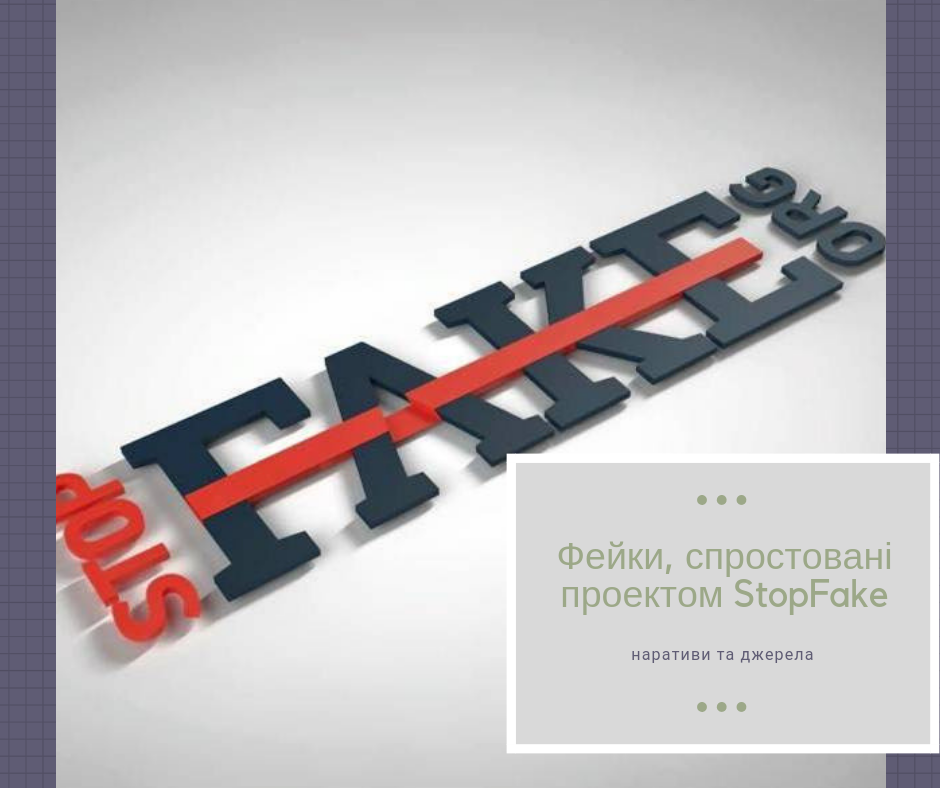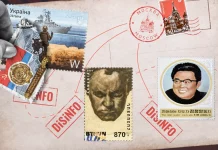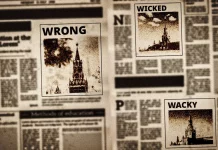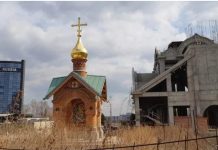This analytical report includes the results of research conducted by StopFake analysts based on archived data of debunked messages from Russian media.
The StopFake project debunked over a thousand fake news stories about Ukraine in the first four years since it was launched. In this research, we present the results of quantitative analysis of fake news debunked by the StopFake team. Using content analysis, StopFake indexed collected materials by source and themes of fake news in order to recreate a comprehensive picture of the media ‘ecosystem’ that generates fake stories about Ukraine, as well as to distinguish what key narratives are constructed by Russian propaganda, including those by means of fake stories. Thus, the main categories of the collected material analysis were sources of fake news and their themes. The unit of analysis was a news story with debunked fake information, published on the StopFake website.
919 stories/messages, published or broadcasted from March 2014 to June 2017 were analysed. Out of these 919 stories, 804 were news pieces.
Content analysis of the debunked fake news helped to identify a comprehensive list of media that were sources or distributors of fake stories, as well as distinguished tendencies in the spreading of fake stories by different types of media. In the second part of the research, we analysed the theme structures of fake stories. The themes distinguished revealed tendencies in the narratives concerning Ukraine constructed by Russian propaganda, for example: the dynamics of promoting certain themes and messages, ways to construct the messages, narrative modification etc.

Sources of Fake Stories
Among the sources of fake stories, StopFake found 178 media outlets. The absolute leaders in spreading untruthful information about Ukraine, were Russian media outlets (85 out of 178). Among the sources of fake news distribution, we also identified 34 Ukrainian media outlets, 20 media outlets from the so-called “Donetsk People’s Republic” and “Luhansk People’s Republic” and 39 media outlets from other countries. A significant number of media outlets from other countries are represented by Czech, Hungarian and Slovakian news websites. Hence, we can say that Russian propaganda functions in a full-scale distribution ‘ecosystem’ of untruthful information together with other types of propaganda materials (for example, biased ‘analytics’ etc.). The ramifications of such an ecosystem have both an external and an internal dimension.
The external dimension includes a network of media outlets and international speakers, affiliated with Russia, and support for alternative media outlets and nongovernmental organizations in different countries.
The internal ramifications are represented by the large number of media organizations, of various types, used for the distribution of propaganda content. For instance, analysis of debunked fake stories about Ukraine showed the following leaders among Russian media outlets: the largest amount of fake news was generated by Zvezda, the media holding of the Ministry of Defence of Russia (79 stories), in second place was the website Ukraina.ru (73 stories), and in third place – the information agency RIA Novosti (62 stories).
The sources of a significant number of fake news were also TV channels, such as Rossiya 24 (48 stories), RT (38 stories), LIFE (38 stories), NTV (32 stories), TASS information agency (31 stories), Lenta.ru (30 stories), Perviy Kanal (The First Channel) (25 stories), and Komsomolskaya Pravda (20 stories). Thus, it can be stated that Russian propaganda is deliberately spread by a wide network of media, which includes Russian state information agencies (RIA Novosti, TASS) and TV channels (Rossiya 24, RT), as well as private media outlets (LIFE, NTV etc.); both TV and the written press (for example, Komsomolskaya Pravda, Izvestiya), as well as online media (Lenta.ru, Vzglyad.ru and so on).

The amount of fake materials distributed by leading Russian media outlets signifies a systematic effort behind propaganda distribution. Even though the list of media outlets identified by StopFake includes among the distributors of untruthful information some Ukrainian media outlets or those that disguise themselves as Ukrainian, the number of fakes media of other countries spread compared to the leading Russian media outlets is significantly smaller. For example, the largest number of fake stories among the so-called ‘Ukrainian’ media outlets, 7 articles to be precise, was found on the website http://nahnews.org (the so-called “Kharkiv News Agency”). As it is known now, the so-called Kharkiv News Agency is a part of the St. Petersburg ‘Troll Factory’. This website, as well as many other similar ones, is, in fact, directly administered and edited from Russia and does not have a single correspondent in Kharkiv. It is also worth noting that nahnews.org continuously repeats the key points of Russian propaganda about Ukraine.
Six stories were identified as fake on the Obozrevatel website. The rest of the Ukrainian and foreign media were sources of not more than 1-3 fake stories among those StopFake debunked.
Themes of Fake Stories
After analysing a sample of 500 articles, examples of the Kremlin propaganda, 18 uniting narrative themes were identified. Yevhen Fedchenko, co-founder of StopFake, was the first to distinguish this classification in his article Kremlin Propaganda: Soviet Active Measures by Other Means (Estonian Journal of Military Studies), Volume 2, 2016, pp. 140–169 www.ksk.edu.ee/publikatsioonid):
- Сoup d’état in Ukraine
- Ukraine as a ‘fascist state’
- Ukraine as a ‘failed state’
- Russia is not a part of the occupation/war in Ukraine
- Discrediting of the Ukrainian Army
- Fake stories discrediting the volunteer battalions that officially became a part of Ukraine’s Armed Forces in 2015
- Internally displaced persons (IDPs) and refugees from Donbass and Crimea
- Territorial disintegration of Ukraine
- ‘Territorial claims’ from neighbouring countries (claims for some parts of Ukraine that would be annexed by such countries as Poland, Hungary, Romania or Slovakia)
- Fake legitimization of Crimea annexation and occupation of Crimea by foreign governments, international organizations or foreign media
- Fake stories that ‘explain’ the war in Ukraine is actually conducted by the US, NATO or Western private contractors
- Decline of Western support for Ukraine – West is ‘tired of Ukrainian issues’
- International organizations manipulated
- Fakes that manipulate with political and economic relations between Ukraine and the EU (for example, the visa-free regime, Free Trade Agreement, Eurovision Song Contest etc.)
- Stories about the disintegration of the EU, decay of the US and West in general, the ‘civil war’ allegedly going on there, their insignificance in international geopolitics
- MH17
- Fakes about the West using biological weapons against Ukraine and or on the temporarily occupied territories (AIDS/Zika/ other disease stories)
- Fake mix-up of the themes – Ukraine/Syria/ISIS terrorists (for example, Crimean Tatars depicted as jihadists, Ukraine depicted as a training ground for terrorists (http://www.ksk.edu.ee/wp-content/uploads/2016/12/soigiadlane_2_www.pdf, p.159).
 Other
Other
Ukrainian Army
Ukraine as a ‘fascist state’
Annexing of Crimea
Degradation of Ukrainian politicians
The war in Ukraine is conducted by the US, NATO or private armies
A decline of Western support for Ukraine
Ukraine and the EU
How bad the situation in Ukraine is
Ukraine in the context of Turkey/Syria/ISIS
Russia does not participate in the occupation/war
Сoup d’état and Western-backed junta
MH17
Territorial disintegration of Ukraine
Analysis of the theme narratives in fake articles showed, on the one hand, their wide variety, and on the other hand, the persistence in promoting Russian narratives about Ukraine. During these four years, certain focuses were systematically promoted in media that would influence public opinion among different audiences.
In particular, the largest number of debunked articles (121) was concerned with the Ukrainian army and volunteer battalions.
Since the first days of the military confrontation by the Russian occupants, active attacks on the Ukrainian army started in Kremlin media as well. The main goal of those articles was to present the Ukrainian army as the opposite of the Russian army, that is as weak and out of control. The example of this news demonstrates well how Russian propaganda was constructing destabilizing and aggressive rhetoric about shaping attitudes towards the Ukrainian military. While describing the Ukrainian side, Russian media were using terms such as ‘armed coup d’état’, ‘Kyiv regime’, ‘junta’, ‘deserters’, and placed a clear heroic focuses on Russia – ‘Russia helps its brother nations’, ‘Russia does not conduct war’, ‘the Russian army is noble and peacekeeping’. Hence, Russian propaganda not only distorted the contents and manipulated them by creating certain artificial myths and concepts, but it also conducted value and ethical inversion, wherein a criminal is depicted as the victim and the victim is blamed for committing the crime.
Separate significance was given to promoting the idea about the ‘Atrocities of the Ukrainian Army’. In the framework of this narrative’s theme, Russian propaganda created a number of shocking and completely fake stories, telling of large-scale atrocities by the Ukrainian military. We can mention a well-known example, that of a propagandistic video story, telling of alleged atrocities by the Ukrainian military in the village of Stepanivka in the Shakhtarsk district in the Donetsk region. On November 2, 2014, the Perviy Kanal (the First Channel) broadcasted a video about military actions in that village. In the news package, Viktor Bikodorov, the self-proclaimed ‘Head of the Village Community’, says that the Ukrainian military entered the village and gathered all the inhabitants in one place. When the locals asked them, “Why are you fighting on our land?”, the response allegedly was: “We were promised a plot of land and two slaves”. This video is an excellent example of the absurd and open manipulation by Russian propagandists. This package did not contain any evidence or official proof of what was alleged to have been said. The video contained a dynamic sequence of video shots, which were, in fact, a synthesis of episodes filmed in the village of Stepanivka in 2014 with documentary newsreel of atrocities from the Second World War. The reporters referred to the Ukrainian army as ‘punishers’, while the video sequence of atrocities conducted by German and fascist occupants served as the manipulative analogy between these events. The journalists of the Russian First Channel were associating Ukrainians with fascists without any evidence, creating a negative attitude among the TV audience towards them. At the same time, the authors of that story kept silent on the fact that it was actually the separatists who destroyed the village during the shelling.
Numerous untruthful news stories about how, allegedly, ‘the punishers have beaten up soldiers’ mothers’, ‘destroyed kindergartens’, ‘killed priests’, ‘shot peaceful villagers’ were the emotional packages produced without any logic, arguments or evidence and had a psychological impact on the audience, while creating fear and a very negative attitude towards the Ukrainian military in general.
Thus, one story out of nine contained untruthful information about the Ukrainian military, aiming to create a criminalized image of the Ukrainian armed forces and delegitimize them.
The second most popular narrative was that of Ukraine as a ‘fascist state’ (82 articles).
A significant number of fake stories were about the annexing of Crimea (69), degradation of Ukrainian politics (69), as well as ‘news’ stories allegedly proving that the war in Ukraine is organized by the US and/or NATO and that private contractors are fighting from the Ukrainian side (66).
In their attempt to create a negative image of the Ukrainian military and its command as enemies and attackers who are both merciless and unprofessional, Russian propaganda combines this theme with the narrative of “the key enemy – the West”, which is allegedly conducting a global geopolitical war against Russia, with Ukraine as simply a battlefield in this fight. In this context, the image of the Ukrainian army was given new content components. According to numerous messages, which were published in the Russian media, it is the West (the US and NATO) that conducts the war in Ukraine. Such messages include: “US contractors are fighting on the Ukrainian side”, “Afro-Americans are fighting in the Ukrainian army”, “A Polish private company, ASBS Othago, is fighting on the Ukrainian side”, “Drunk Americans caused a fight in Mariupol”.
Another clear example that contains the full spectrum of Russian propaganda concerning the discreditation of the Ukrainian army was the narrative theme around flight MH17 (33). Numerous media materials, blaming the Ukrainian army, mentioned that Western countries decided that guilt lay on the Ukrainian side and invented conclusions of investigative commissions.
“Ukraine was willing to down a Russian spy airplane, that turned out to be a civilian aircraft, which simply was not aware that Ukraine had been designated as a no-fly zone”, the RIA Novosti article quotes Andrey Purgin from the so-called “Donetsk People’s Republic”.
“The possible target of the Ukrainian missile that hit the Malaysian Airlines Boeing 777 could have been the plane of the President of Russia, a source in the Russian aviation authority says. The President’s plane crossed the path of the Malaysian airliner at one point and in one echelon near Warsaw”, an RT piece says.
However, in the case of flight MH17, the main goal of the Russian media was not to create an image of a guilty person, because more facts and evidence proved that the Ukrainian side was not involved in this crime, but rather to create an “information noise” effect, when the audience stops analysing completely and simply accepts the position broadcasted by the media because of numerous information messages on a certain event.
Such theme narratives as “Decline of Western support for Ukraine” (50 materials) and “Ukraine-EU relations” (46) also received a lot of attention.
At the end of 2015, the propagandistic theme in the context of Ukraine changed and was given new meaning. The geopolitical scope of Russia and the universal nature of propaganda methods they use for different countries, such as Syria, Turkey, Germany and so on, became obvious. The coverage of themes connected to Ukrainian, Turkish and Syrian issues transformed in a peculiar way. The Russian media broadcasted the following stories: “Turkish Bandera Supporters: Jihadists Fight in Ukraine” (Rossiya 24 TV channel), “Azov Battalion is Ready to Fight against Russia in Syria along Turkey” (RT), “Ukrainians Are Fighting on the Syrian Terrorist Side” (nhnews.com.ua) (35 stories). In this case, Russian media create a synthetic image of the enemy, which allegedly contains all the main threats for Russia.
In general, analysis of the theme narratives of fake news stories demonstrates continuous attempts of Russian propaganda to construct an image of Ukraine as a failed state, by means of delegitimization of its armed forces, government and policies in different areas. Another key element for the construction of Ukraine’s image, along with the failed state one, is to show Ukrainian society as such where the ultraright opinions and groups gain more weight.
Research authors: Daria Orlova, Olga Makar, Viktoria Romaniuk, Maria Zhdanova





